Advances in the Toxicity Assessment of Silver Nanoparticles Derived from a Sphagnum fallax Extract for Monolayers and Spheroids
Abstract
1. Introduction
2. Material and Methods
2.1. Chemicals
2.2. Cell Culture
2.3. Obtaining the Sphagnum fallax Moss Extract
2.3.1. Extraction Method
2.3.2. Citrate Method
2.4. Characteristics of AgNPs
2.4.1. Optical Absorption Spectroscopy
2.4.2. Nanoparticle Size
2.4.3. Stability of the Nanoparticles
2.4.4. Dark-Field Microscopy with Hyperspectral Analysis
2.4.5. Fourier Transform Infrared Spectroscopy
2.5. Phytochemical Analysis
2.5.1. Test for Phenolics
2.5.2. Test for Terpenoids
2.5.3. Test for Glycosides
2.5.4. Test for Saponins
2.5.5. Detection of Tannins
2.5.6. Test for Alkaloids
2.6. Assessment of Cytotoxicity
2.6.1. Cell Viability Assessment (MTT Analysis)
2.6.2. Cell Viability Analysis with the Resazurin Reduction Assay
2.6.3. Visualization of the Cells
2.6.4. Assessment of the Cell Index
2.6.5. Induction of Necrosis
2.7. Spheroids
2.8. Statistical Analysis
3. Results and Discussion
3.1. Effects of Extract-Stabilized and Citrate-Stabilized AgNPs on the Physiological Properties of Human Cells
3.2. Interaction of AgNPs with Cells
3.3. Spheroids
4. Conclusions
Supplementary Materials
Author Contributions
Funding
Institutional Review Board Statement
Informed Consent Statement
Data Availability Statement
Conflicts of Interest
References
- Mueller, N.C.; Nowack, B. Predicting Bioaccumulation of Nanomaterials: Modeling Approaches with Challenges. Environ. Sci. Technol. 2008, 42, 4447–4453. [Google Scholar] [CrossRef]
- Tufail, M.S.; Liaqat, I. Silver nanoparticles and their applications—A comprehensive review. Pure Appl. Biol. (PAB) 2021, 11, 315–330. [Google Scholar] [CrossRef]
- Gottschalk, F.; Nowack, B.J. The release of engineered nanomaterials to the environment. Environ. Monit. 2011, 13, 1145–1155. [Google Scholar] [CrossRef] [PubMed]
- Mikhailova, E.O. Silver nanoparticles: Mechanism of action and probable bio-application. J. Func. Biomater. 2020, 11, 84. [Google Scholar] [CrossRef] [PubMed]
- Akhtar, M.S.; Panwar, J.; Yun, Y.-S. Biogenic Synthesis of Metallic Nanoparticles by Plant Extracts. ACS Sustain. Chem. Eng. 2013, 1, 591–602. [Google Scholar] [CrossRef]
- Kumar, P.; Robins, A.; Vardoulakis, S.; Britter, R. A Review of the Characteristics of Nanoparticles in the Urban Atmosphere and the Prospects for Developing Regulatory Controls. Atmos. Environ. 2010, 44, 5035–5052. [Google Scholar] [CrossRef]
- Syed, A.; Saraswati, S.; Kundu, G.C.; Ahmad, A. Biological Synthesis of Silver Nanoparticles Using the Fungus Humicola Sp. and Evaluation of Their Cytoxicity Using Normal and Cancer Cell Lines. Spectrochim. Acta Part A Mol. Biomol. Spectrosc. 2013, 114, 144–147. [Google Scholar] [CrossRef]
- Narware, J.; Singh, S.P.; Manzar, N.; Kashyap, A.S. Biogenic synthesis, characterization, and evaluation of synthesized nanoparticles against the pathogenic fungus Alternaria solani. Front. Microbiol. 2023, 14, 1159251. [Google Scholar] [CrossRef] [PubMed]
- Shivaji, S.; Madhu, S.; Singh, S. Extracellular Synthesis of Antibacterial Silver Nanoparticles Using Psychrophilic Bacteria. Process Biochem. 2011, 46, 1800–1807. [Google Scholar] [CrossRef]
- Ahmed, A.; Usman, M.; Ji, Z.; Rafiq, M.; Yu, B.; Shen, Y.; Cong, H. Nature-inspired biogenic synthesis of silver nanoparticles for antibacterial applications. Mater. Today Chem. 2023, 27, 101339. [Google Scholar] [CrossRef]
- Sharma, D.; Kanchi, S.; Bisetty, K. Biogenic Synthesis of Nanoparticles: A Review. Arab. J. Chem. 2019, 12, 3576–3600. [Google Scholar] [CrossRef]
- Van Breemen, N. How Sphagnum Bogs down Other Plants. Trends Ecol. Evol. 1995, 10, 270–275. [Google Scholar] [CrossRef] [PubMed]
- Fudyma, J.D.; Lyon, J.; Amini Tabrizi, R.; Gieschen, H.; Chu, R.K.; Hoyt, D.W.; Kyle, J.E.; Toyoda, J.; Tolic, N.; Heyman, H.M.; et al. Untargeted Metabolomic Profiling of Sphagnum Fallax Reveals Novel Antimicrobial Metabolites. Plant Direct. 2019, 3, e00179. [Google Scholar] [CrossRef] [PubMed]
- Zych, M.; Urbisz, K.; Kimsa-Dudek, M.; Kamionka, M.; Dudek, S.; Raczak, B.K.; Wacławek, S.; Chmura, D.; Kaczmarczyk-Żebrowska, I.; Stebel, A. Effects of Water–Ethanol Extracts from Four Sphagnum Species on Gene Expression of Selected Enzymes in Normal Human Dermal Fibroblasts and Their Antioxidant Properties. Pharmaceuticals 2023, 16, 1076. [Google Scholar] [CrossRef] [PubMed]
- Bai, X.; Bu, Z.J.; Chen, X. Morphology of Chrysophycean Stomatocysts in Three Peatlands in Central China. Mires Peat 2018, 21, 1–16. [Google Scholar] [CrossRef]
- Hou, D.; O’Connor, D.; Igalavithana, A.D.; Alessi, D.S.; Luo, J.; Tsang, D.C.W.; Sparks, D.L.; Yamauchi, Y.; Rinklebe, J.; Ok, Y.S. Metal Contamination and Bioremediation of Agricultural Soils for Food Safety and Sustainability. Nat. Rev. Earth Environ. 2020, 1, 366–381. [Google Scholar] [CrossRef]
- Rahman, M.A.; Zaman, N.; Asyhari, A.T.; Al-Turjman, F.; Bhuiyan, M.Z.A.; Zolkipli, M.F. Data-Driven Dynamic Clustering Framework for Mitigating the Adverse Economic Impact of Covid-19 Lockdown Practices. Sustain. Cities Soc. 2020, 62, 102372. [Google Scholar] [CrossRef]
- Wang, Z.; Cui, K.; Costabel, U.; Zhang, X. Nanotechnology-facilitated vaccine development during the coronavirus disease 2019 (COVID-19) pandemic. Exploration 2022, 2, 20210082. [Google Scholar] [CrossRef]
- García-Quintero, A.; Palencia, M. A Critical Analysis of Environmental Sustainability Metrics Applied to Green Synthesis of Nanomaterials and the Assessment of Environmental Risks Associated with the Nanotechnology. Sci. Total Environ. 2021, 793, 148524. [Google Scholar] [CrossRef]
- Scandorieiro, S.; Teixeira, F.M.M.B.; Nogueira, M.C.L.; Panagio, L.A.; de Oliveira, A.G.; Durán, N.; Nakazato, G.; Kobayashi, R.K.T. Antibiofilm Effect of Biogenic Silver Nanoparticles Combined with Oregano Derivatives against Carbapenem-Resistant Klebsiella pneumoniae. Antibiotics 2023, 12, 756. [Google Scholar] [CrossRef]
- Zaheer, Z.; Bawazir, W.A.; Basaleh, A.S.; Alhogbi, B.G.; Albukhari, S.M. Effects of anionic and cationic surfactants on the surface Plasmon resonance intensity of biogenic silver nanoparticles: Stability, and position of optical band. J. Mol. Liq. 2023, 385, 122363. [Google Scholar] [CrossRef]
- Akhatova, F.; Konnova, S.; Kryuchkova, M.; Batasheva, S.; Mazurova, K.; Vikulina, A.; Volodkin, D.; Rozhina, E. Comparative Characterization of Iron and Silver Nanoparticles: Extract-Stabilized and Classical Synthesis Methods. Int. J. Mol. Sci. 2023, 24, 9274. [Google Scholar] [CrossRef]
- Vishwanath, R.; Negi, B. Conventional and Green Methods of Synthesis of Silver Nanoparticles and Their Antimicrobial Properties. Curr. Res. Green Sustain. Chem. 2021, 4, 100205. [Google Scholar] [CrossRef]
- Rakhmatullina, A.; Mingaleeva, R.; Gafurbaeva, D.; Glazunova, O.; Sagdeeva, A.; Bulatov, E.; Rizvanov, A.; Miftakhova, R. Adipose-Derived Mesenchymal Stem Cell (MSC) Immortalization by Modulation of hTERT and TP53 Expression Levels. J. Pers. Med. 2023, 13, 1621. [Google Scholar] [CrossRef] [PubMed]
- Akhatova, F.; Danilushkina, A.; Kuku, G.; Saricam, M.; Culha, M.; Fakhrullin, R. Simultaneous Intracellular Detection of Plasmonic and Non-Plasmonic Nanoparticles Using Dark-Field Hyperspectral Microscopy. Bull. Chem. Soc. Jpn. 2018, 91, 1640–1645. [Google Scholar] [CrossRef]
- Ahmed, S.I.; Jamil, S.; Ismatullah, H.; Hussain, R.; Bibi, S.; Khandaker, M.U.; Naveed, A.; Idris, A.M.; Emran, T.B. A Comprehensive Perspective of Traditional Arabic or Islamic Medicinal Plants as an Adjuvant Therapy against COVID-19. Saudi J. Biol. Sci. 2023, 30, 103561. [Google Scholar] [CrossRef] [PubMed]
- Mengesha Yessuf, A. Phytochemical Extraction and Screening of Bio Active Compounds from Black Cumin (Nigella Sativa) Seeds Extract. Am. J. Life Sci. 2015, 3, 358. [Google Scholar] [CrossRef]
- Sreevidya, N.; Mehrotra, S. Spectrophotometric Method for Estimation of Alkaloids Precipitable with Dragendorff’s Reagent in Plant Materials. J. Aoac Int. 2003, 86, 1124–1127. [Google Scholar] [CrossRef]
- Dzamukova, M.R.; Naumenko, E.A.; Rozhina, E.V.; Trifonov, A.A.; Fakhrullin, R.F. Cell Surface Engineering with Polyelectrolyte-Stabilized Magnetic Nanoparticles: A Facile Approach for Fabrication of Artificial Multicellular Tissue-Mimicking Clusters. Nano Res. 2015, 8, 2515–2532. [Google Scholar] [CrossRef]
- Timmins, N.E.; Nielsen, L.K. Generation of Multicellular Tumor Spheroids by the Hanging-Drop Method. In Tissue Engineering; Hauser, H., Fussenegger, M., Eds.; Methods in Molecular MedicineTM; Humana Press: Totowa, NJ, USA, 2007; Volume 140, pp. 141–151. ISBN 978-1-58829-756-3. [Google Scholar]
- Rozhina, E.; Batasheva, S.; Gomzikova, M.; Naumenko, E.; Fakhrullin, R. Multicellular Spheroids Formation: The Synergistic Effects of Halloysite Nanoclay and Cationic Magnetic Nanoparticles. Colloids Surf. A Physicochem. Eng. Asp. 2019, 565, 16–24. [Google Scholar] [CrossRef]
- Anjum, S.; Chaudhary, R.; Khan, A.K.; Hashim, M.; Anjum, I.; Hano, C.; Abbasi, B.H. Light-Emitting Diode (LED)-Directed Green Synthesis of Silver Nanoparticles and Evaluation of Their Multifaceted Clinical and Biological Activities. RSC Adv. 2022, 12, 22266–22284. [Google Scholar] [CrossRef] [PubMed]
- Braakhuis, H.M.; Gosens, I.; Krystek, P.; Boere, J.A.; Cassee, F.R.; Fokkens, P.H.; Post, J.A.; Van Loveren, H.; Park, M.V. Particle Size Dependent Deposition and Pulmonary Inflammation after Short-Term Inhalation of Silver Nanoparticles. Part. Fibre Toxicol. 2014, 11, 49. [Google Scholar] [CrossRef] [PubMed]
- Mourdikoudis, S.; Pallares, R.M.; Thanh, N.T.K. Characterization Techniques for Nanoparticles: Comparison and Complementarity upon Studying Nanoparticle Properties. Nanoscale 2018, 10, 12871–12934. [Google Scholar] [CrossRef] [PubMed]
- Pinho, B.; Torrente-Murciano, L. Continuous Manufacturing of Silver Nanoparticles between 5 and 80 Nm with Rapid Online Optical Size and Shape Evaluation. React. Chem. Eng. 2020, 5, 342–355. [Google Scholar] [CrossRef]
- Chaudhari, K.; Pradeep, T. Spatiotemporal Mapping of Three Dimensional Rotational Dynamics of Single Ultrasmall Gold Nanorods. Sci. Rep. 2014, 4, 5948. [Google Scholar] [CrossRef] [PubMed]
- Cordani, M.; Somoza, Á. Targeting Autophagy Using Metallic Nanoparticles: A Promising Strategy for Cancer Treatment. Cell. Mol. Life Sci. 2019, 76, 1215–1242. [Google Scholar] [CrossRef] [PubMed]
- Jegadeeswaran, P.; Jegadeeswaran, R.; Venckatesh, R. Green Synthesis of Silver Nanoparticles from Extract of Padina Tetrastromatica Leaf. Dig. J. Nanomater. Biostructures 2012, 7, 991–998. [Google Scholar]
- Kaviya, S.; Santhanalakshmi, J.; Viswanathan, B.; Muthumary, J.; Srinivasan, K. Biosynthesis of silver nanoparticles using Citrus sinensis peel extract and its antibacterial activity. Spectrochim. Acta Part A 2011, 79, 594–598. [Google Scholar] [CrossRef] [PubMed]
- Nadagouda, M.N.; Varma, R.S. Green Synthesis of Silver and Palladium Nanoparticles at Room Temperature Using Coffee and Tea Extract. Green Chem. 2008, 10, 859. [Google Scholar] [CrossRef]
- Siemieniec, J.; Kafarski, P.; Plucinski, P. Hydrophosphonylation of Nanoparticle Schiff Bases as a Mean for Preparation of Aminophosphonate-Functionalized Nanoparticles. Molecules 2013, 18, 8473–8484. [Google Scholar] [CrossRef]
- Anandalakshmi, K.; Venugobal, J.; Ramasamy, V. Characterization of Silver Nanoparticles by Green Synthesis Method Using Pedalium Murex Leaf Extract and Their Antibacterial Activity. Appl. Nanosci. 2016, 6, 399–408. [Google Scholar] [CrossRef]
- Jyoti, K.; Baunthiyal, M.; Singh, A. Characterization of Silver Nanoparticles Synthesized Using Urtica Dioica Linn. Leaves and Their Synergistic Effects with Antibiotics. J. Radiat. Res. Appl. Sci. 2016, 9, 217–227. [Google Scholar] [CrossRef]
- Otunola, G.; Afolayan, A.; Ajayi, E.; Odeyemi, S. Characterization, Antibacterial and Antioxidant Properties of Silver Nanoparticles Synthesized from Aqueous Extracts of Allium Sativum, Zingiber Officinale, and Capsicum Frutescens. Phcog. Mag. 2017, 13, 201. [Google Scholar] [CrossRef] [PubMed]
- Gondwal, M.; Joshi nee Pant, G. Synthesis and Catalytic and Biological Activities of Silver and Copper Nanoparticles Using Cassia occidentalis. Int. J. Biomater. 2018, 2018, 6735426. [Google Scholar] [CrossRef] [PubMed]
- de Lima, R.; Seabra, A.B.; Durán, N. Silver Nanoparticles: A Brief Review of Cytotoxicity and Genotoxicity of Chemically and Biogenically Synthesized Nanoparticles: Genotoxicity of Silver Nanoparticles. J. Appl. Toxicol. 2012, 32, 867–879. [Google Scholar] [CrossRef] [PubMed]
- Syafiuddin, A.; Salmiati; Salim, M.R.; Beng Hong Kueh, A.; Hadibarata, T.; Nur, H. A Review of Silver Nanoparticles: Research Trends, Global Consumption, Synthesis, Properties, and Future Challenges. J. Chin. Chem. Soc. 2017, 64, 732–756. [Google Scholar] [CrossRef]
- Durán, N.; Durán, M.; De Souza, C. Silver and Silver Chloride Nanoparticles and Their Anti-Tick Activity: A Mini Review. J. Braz. Chem. Soc. 2017, 28, 927–932. [Google Scholar] [CrossRef]
- Baun, A.; Sayre, P.; Steinhäuser, K.G.; Rose, J. Regulatory Relevant and Reliable Methods and Data for Determining the Environmental Fate of Manufactured Nanomaterials. NanoImpact 2017, 8, 1–10. [Google Scholar] [CrossRef]
- Foster, K.A.; Oster, C.G.; Mayer, M.M.; Avery, M.L.; Audus, K.L. Characterization of the A549 Cell Line as a Type II Pulmonary Epithelial Cell Model for Drug Metabolism. Exp. Cell Res. 1998, 243, 359–366. [Google Scholar] [CrossRef]
- Piñeiro-Ramil, M.; Sanjurjo-Rodríguez, C.; Castro-Viñuelas, R.; Rodríguez-Fernández, S.; Fuentes-Boquete, I.M.; Blanco, F.J.; Díaz-Prado, S.M. Usefulness of Mesenchymal Cell Lines for Bone and Cartilage Regeneration Research. Int. J. Mol. Sci. 2019, 20, 6286. [Google Scholar] [CrossRef]
- Kumar, P.; Nagarajan, A.; Uchil, P.D. Analysis of Cell Viability by the MTT Assay. Cold Spring Harb. Protoc. 2018, 2018, pdb.prot095505. [Google Scholar] [CrossRef] [PubMed]
- Kumar, P.; Nagarajan, A.; Uchil, P.D. Analysis of Cell Viability by the alamarBlue Assay. Cold Spring Harb. Protoc. 2018, 2018, pdb.prot095489. [Google Scholar] [CrossRef] [PubMed]
- Angius, F.; Floris, A. Liposomes and MTT Cell Viability Assay: An Incompatible Affair. Toxicol. In Vitr. 2015, 29, 314–319. [Google Scholar] [CrossRef] [PubMed]
- Golovinskaya, O.V.; Baykova, M.L.; Alpatova, N.A.; Zubkov, D.A.; Fomenko, V.V.; Gayderova, L.A. Comparative Analysis of Dyes Used in the Assessment of Filgrastim Products Specific Activity by Biological in Vitro Methods. Bioprep. Profil. Diagn. Lechenie 2020, 20, 193–201. [Google Scholar] [CrossRef]
- Milić, M.; Leitinger, G.; Pavičić, I.; Zebić Avdičević, M.; Dobrović, S.; Goessler, W.; Vinković Vrček, I. Cellular uptake and toxicity effects of silver nanoparticles in mammalian kidney cells. J. Appl. Toxicol. 2015, 35, 581–592. [Google Scholar] [CrossRef] [PubMed]
- AshaRani, P.V.; Low Kah Mun, G.; Hande, M.P.; Valiyaveettil, S. Cytotoxicity and Genotoxicity of Silver Nanoparticles in Human Cells. ACS Nano 2009, 3, 279–290. [Google Scholar] [CrossRef] [PubMed]
- Li, Y.; Li, X.; Li, Z.; Gao, H. Surface-Structure-Regulated Penetration of Nanoparticles across a Cell Membrane. Nanoscale 2012, 4, 3768. [Google Scholar] [CrossRef] [PubMed]
- Kumar, G.; Degheidy, H.; Casey, B.J.; Goering, P.L. Flow Cytometry Evaluation of in Vitro Cellular Necrosis and Apoptosis Induced by Silver Nanoparticles. Food Chem. Toxicol. 2015, 85, 45–51. [Google Scholar] [CrossRef] [PubMed]
- Li, L.; Bi, Z.; Hu, Y.; Sun, L.; Song, Y.; Chen, S.; Mo, F.; Yang, J.; Wei, Y.; Wei, X. Silver Nanoparticles and Silver Ions Cause Inflammatory Response through Induction of Cell Necrosis and the Release of Mitochondria in Vivo and in Vitro. Cell Biol. Toxicol. 2021, 37, 177–191. [Google Scholar] [CrossRef]
- Seiffert, J.; Buckley, A.; Leo, B.; Martin, N.G.; Zhu, J.; Dai, R.; Hussain, F.; Guo, C.; Warren, J.; Hodgson, A.; et al. Pulmonary Effects of Inhalation of Spark-Generated Silver Nanoparticles in Brown-Norway and Sprague–Dawley Rats. Respir. Res. 2016, 17, 85. [Google Scholar] [CrossRef]
- Seiffert, J.; Hussain, F.; Wiegman, C.; Li, F.; Bey, L.; Baker, W.; Porter, A.; Ryan, M.P.; Chang, Y.; Gow, A.; et al. Pulmonary Toxicity of Instilled Silver Nanoparticles: Influence of Size, Coating and Rat Strain. PLoS ONE 2015, 10, e0119726. [Google Scholar] [CrossRef] [PubMed]
- Cheng, Y.; Yin, L.; Lin, S.; Wiesner, M.; Bernhardt, E.; Liu, J. Toxicity Reduction of Polymer-Stabilized Silver Nanoparticles by Sunlight. J. Phys. Chem. C 2011, 115, 4425–4432. [Google Scholar] [CrossRef]
- Braakhuis, H.M.; Giannakou, C.; Peijnenburg, W.J.G.M.; Vermeulen, J.; Van Loveren, H.; Park, M.V.D.Z. Simple in Vitro Models Can Predict Pulmonary Toxicity of Silver Nanoparticles. Nanotoxicology 2016, 10, 770–779. [Google Scholar] [CrossRef] [PubMed]
- Barbasz, A.; Oćwieja, M.; Roman, M. Toxicity of Silver Nanoparticles towards Tumoral Human Cell Lines U-937 and HL-60. Colloids Surf. B Biointerfaces 2017, 156, 397–404. [Google Scholar] [CrossRef] [PubMed]
- Gliga, A.R.; Skoglund, S.; Odnevall Wallinder, I.; Fadeel, B.; Karlsson, H.L. Size-Dependent Cytotoxicity of Silver Nanoparticles in Human Lung Cells: The Role of Cellular Uptake, Agglomeration and Ag Release. Part. Fibre Toxicol. 2014, 11, 11. [Google Scholar] [CrossRef] [PubMed]
- Gomes, T.; Araújo, O.; Pereira, R.; Almeida, A.C.; Cravo, A.; Bebianno, M.J. Genotoxicity of Copper Oxide and Silver Nanoparticles in the Mussel Mytilus Galloprovincialis. Mar. Environ. Res. 2013, 84, 51–59. [Google Scholar] [CrossRef] [PubMed]
- Kim, S.; Choi, J.E.; Choi, J.; Chung, K.-H.; Park, K.; Yi, J.; Ryu, D.-Y. Oxidative Stress-Dependent Toxicity of Silver Nanoparticles in Human Hepatoma Cells. Toxicol. Vitr. 2009, 23, 1076–1084. [Google Scholar] [CrossRef] [PubMed]
- Du, J.; Tang, J.; Xu, S.; Ge, J.; Dong, Y.; Li, H.; Jin, M. A Review on Silver Nanoparticles-Induced Ecotoxicity and the Underlying Toxicity Mechanisms. Regul. Toxicol. Pharmacol. 2018, 98, 231–239. [Google Scholar] [CrossRef] [PubMed]
- Mao, B.-H.; Tsai, J.-C.; Chen, C.-W.; Yan, S.-J.; Wang, Y.-J. Mechanisms of Silver Nanoparticle-Induced Toxicity and Important Role of Autophagy. Nanotoxicology 2016, 10, 1021–1040. [Google Scholar] [CrossRef]
- Villeret, B.; Dieu, A.; Straube, M.; Solhonne, B.; Miklavc, P.; Hamadi, S.; Le Borgne, R.; Mailleux, A.; Norel, X.; Aerts, J.; et al. Silver Nanoparticles Impair Retinoic Acid-Inducible Gene I-Mediated Mitochondrial Antiviral Immunity by Blocking the Autophagic Flux in Lung Epithelial Cells. ACS Nano 2018, 12, 1188–1202. [Google Scholar] [CrossRef]
- Fehaid, A.; Taniguchi, A. Silver Nanoparticles Reduce the Apoptosis Induced by Tumor Necrosis Factor-α. Sci. Technol. Adv. Mater. 2018, 19, 526–534. [Google Scholar] [CrossRef] [PubMed]
- Zhang, Y.; Qiang, L.; Yuan, Y.; Wu, W.; Sun, B.; Zhu, L. Impacts of Titanium Dioxide Nanoparticles on Transformation of Silver Nanoparticles in Aquatic Environments. Environ. Sci. Nano 2018, 5, 1191–1199. [Google Scholar] [CrossRef]
- Chithrani, B.D.; Ghazani, A.A.; Chan, W.C.W. Determining the Size and Shape Dependence of Gold Nanoparticle Uptake into Mammalian Cells. Nano Lett. 2006, 6, 662–668. [Google Scholar] [CrossRef] [PubMed]
- Verma, A.; Stellacci, F. Effect of Surface Properties on Nanoparticle–Cell Interactions. Small 2010, 6, 12–21. [Google Scholar] [CrossRef] [PubMed]
- Salmaso, S.; Caliceti, P.; Amendola, V.; Meneghetti, M.; Magnusson, J.P.; Pasparakis, G.; Alexander, C. Cell Up-Take Control of Gold Nanoparticles Functionalized with a Thermoresponsive Polymer. J. Mater. Chem. 2009, 19, 1608. [Google Scholar] [CrossRef]
- Chithrani, B.D.; Chan, W.C.W. Elucidating the Mechanism of Cellular Uptake and Removal of Protein-Coated Gold Nanoparticles of Different Sizes and Shapes. Nano Lett. 2007, 7, 1542–1550. [Google Scholar] [CrossRef] [PubMed]
- Castro-Aceituno, V.; Ahn, S.; Simu, S.Y.; Singh, P.; Mathiyalagan, R.; Lee, H.A.; Yang, D.C. Anticancer Activity of Silver Nanoparticles from Panax Ginseng Fresh Leaves in Human Cancer Cells. Biomed. Pharmacother. 2016, 84, 158–165. [Google Scholar] [CrossRef] [PubMed]
- Gomathi, A.C.; Xavier Rajarathinam, S.R.; Mohammed Sadiq, A.; Rajeshkumar, S. Anticancer Activity of Silver Nanoparticles Synthesized Using Aqueous Fruit Shell Extract of Tamarindus Indica on MCF-7 Human Breast Cancer Cell Line. J. Drug Deliv. Sci. Technol. 2020, 55, 101376. [Google Scholar] [CrossRef]
- Yeşilot, Ş.; Dönmez, S. Cytotoxic Effect of Green Synthesized Silver Nanoparticles with Salvia Officinalis on MCF-7 Human Breast Cancer Cells. Turk. J. Health Sci. Life 2021, 4, 133–139. [Google Scholar]
- Yesilot, S.; Bayram, D.; Özgöçmen, M.; Toğay, V.A. Apoptotic Effects of Phlomis Armeniaca Mediated Biosynthesized Silver Nanoparticles in Monolayer (2D) and Spheroid (3D) Cultures of Human Breast Cancer Cell Lines. 3 Biotech 2023, 13, 4. [Google Scholar] [CrossRef]
- Elje, E.; Mariussen, E.; Moriones, O.H.; Bastús, N.G.; Puntes, V.; Kohl, Y.; Dusinska, M.; Rundén-Pran, E. Hepato(Geno)Toxicity Assessment of Nanoparticles in a HepG2 Liver Spheroid Model. Nanomaterials 2020, 10, 545. [Google Scholar] [CrossRef] [PubMed]
- Lovegrove, J.T.; Kent, B.; Förster, S.; Garvey, C.J.; Stenzel, M.H. The flow of anisotropic nanoparticles in solution and in blood. Exploration 2023, 3, 20220075. [Google Scholar] [CrossRef] [PubMed]
- Jarockyte, G.; Dapkute, D.; Karabanovas, V.; Daugmaudis, J.V.; Ivanauskas, F.; Rotomskis, R. 3D Cellular Spheroids as Tools for Understanding Carboxylated Quantum Dot Behavior in Tumors. Biochim. Et Biophys. Acta (BBA)—Gen. Subj. 2018, 1862, 914–923. [Google Scholar] [CrossRef] [PubMed]
- Henrique, R.B.L.; Lima, R.R.M.; Monteiro, C.A.P.; Oliveira, W.F.; Pereira, G.; Cabral Filho, P.E.; Fontes, A. Advances in the Study of Spheroids as Versatile Models to Evaluate Biological Interactions of Inorganic Nanoparticles. Life Sci. 2022, 302, 120657. [Google Scholar] [CrossRef]
- Priwitaningrum, D.L.; Blondé, J.-B.G.; Sridhar, A.; Van Baarlen, J.; Hennink, W.E.; Storm, G.; Le Gac, S.; Prakash, J. Tumor Stroma-Containing 3D Spheroid Arrays: A Tool to Study Nanoparticle Penetration. J. Control Release 2016, 244, 257–268. [Google Scholar] [CrossRef]
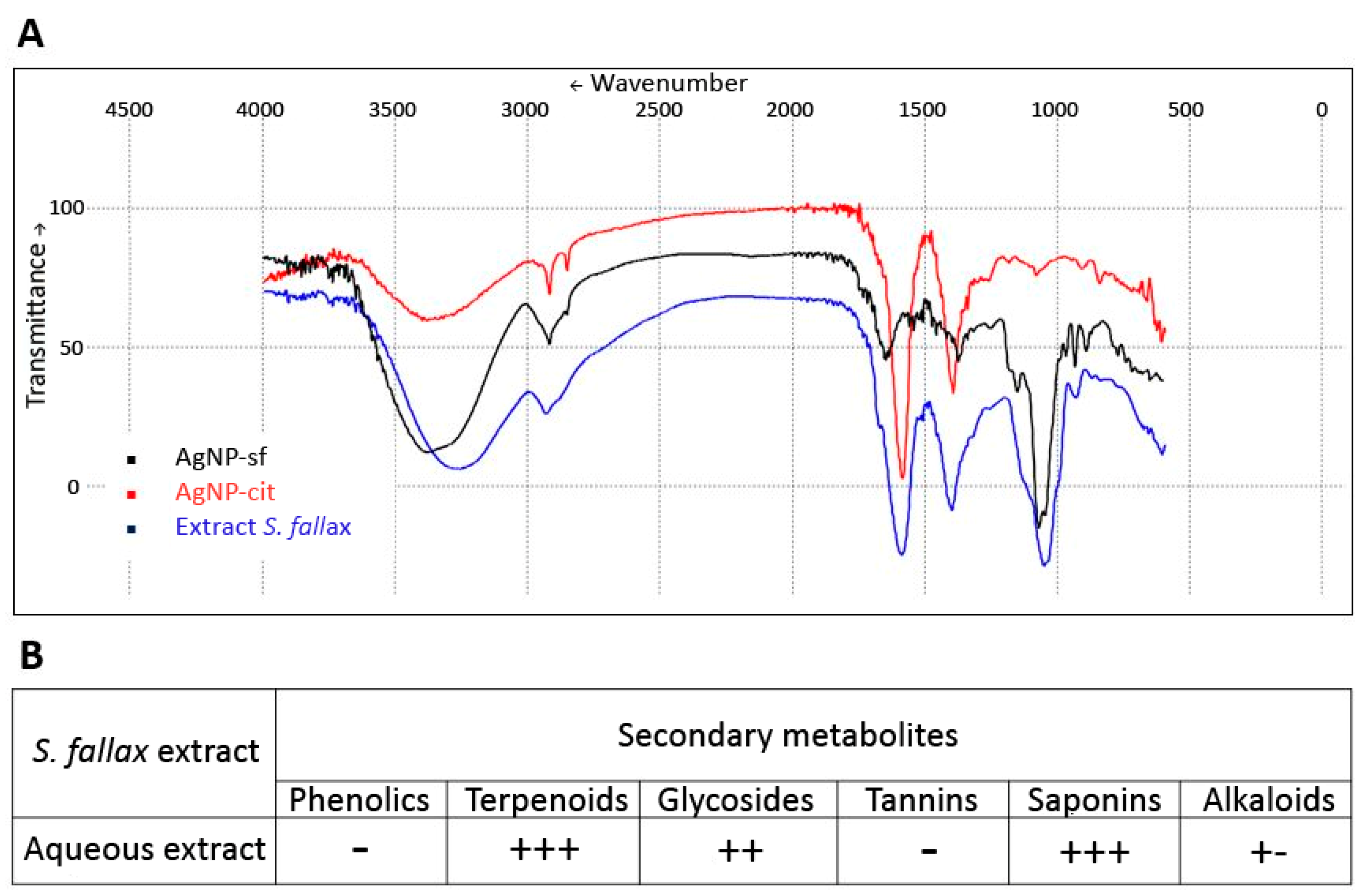
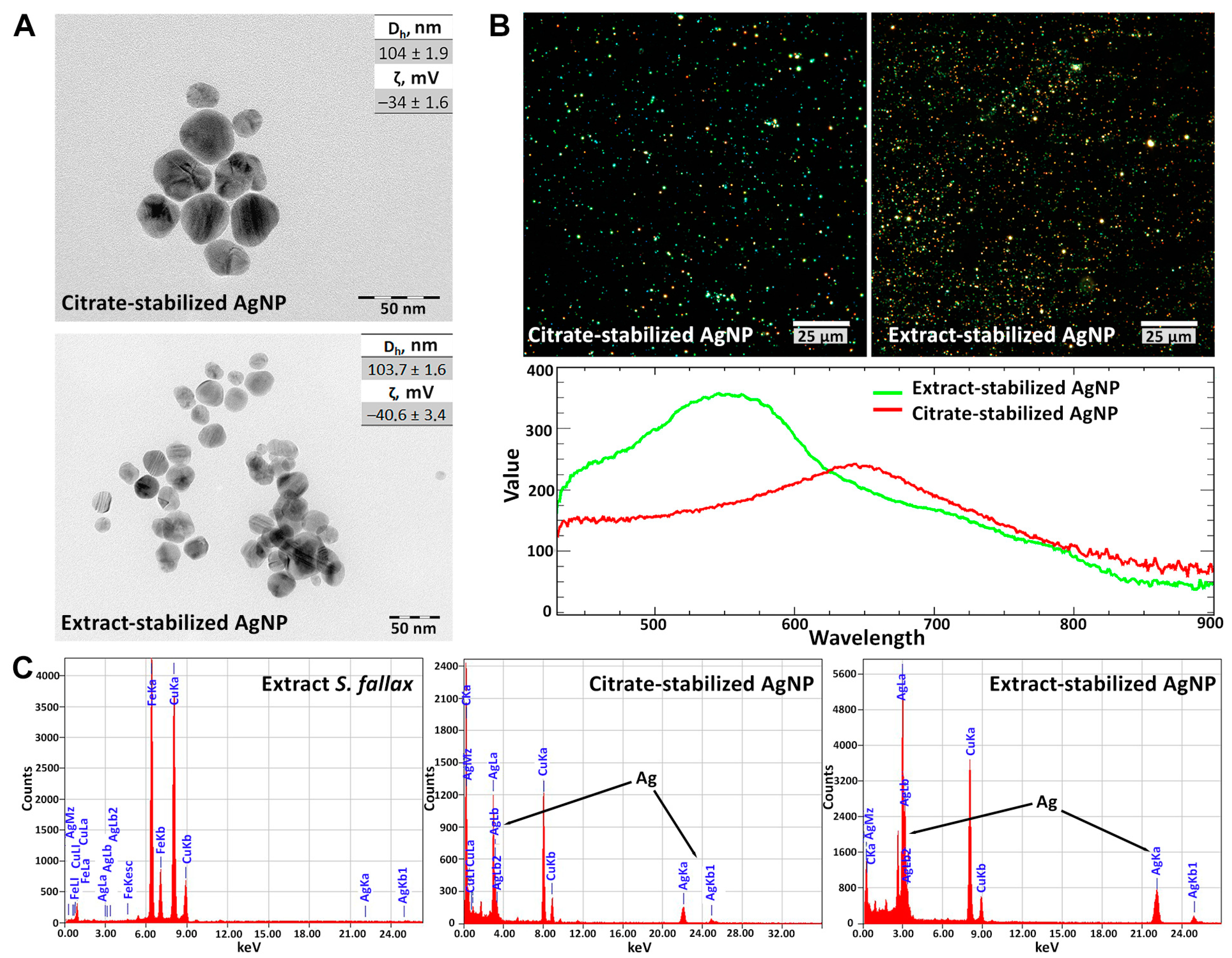
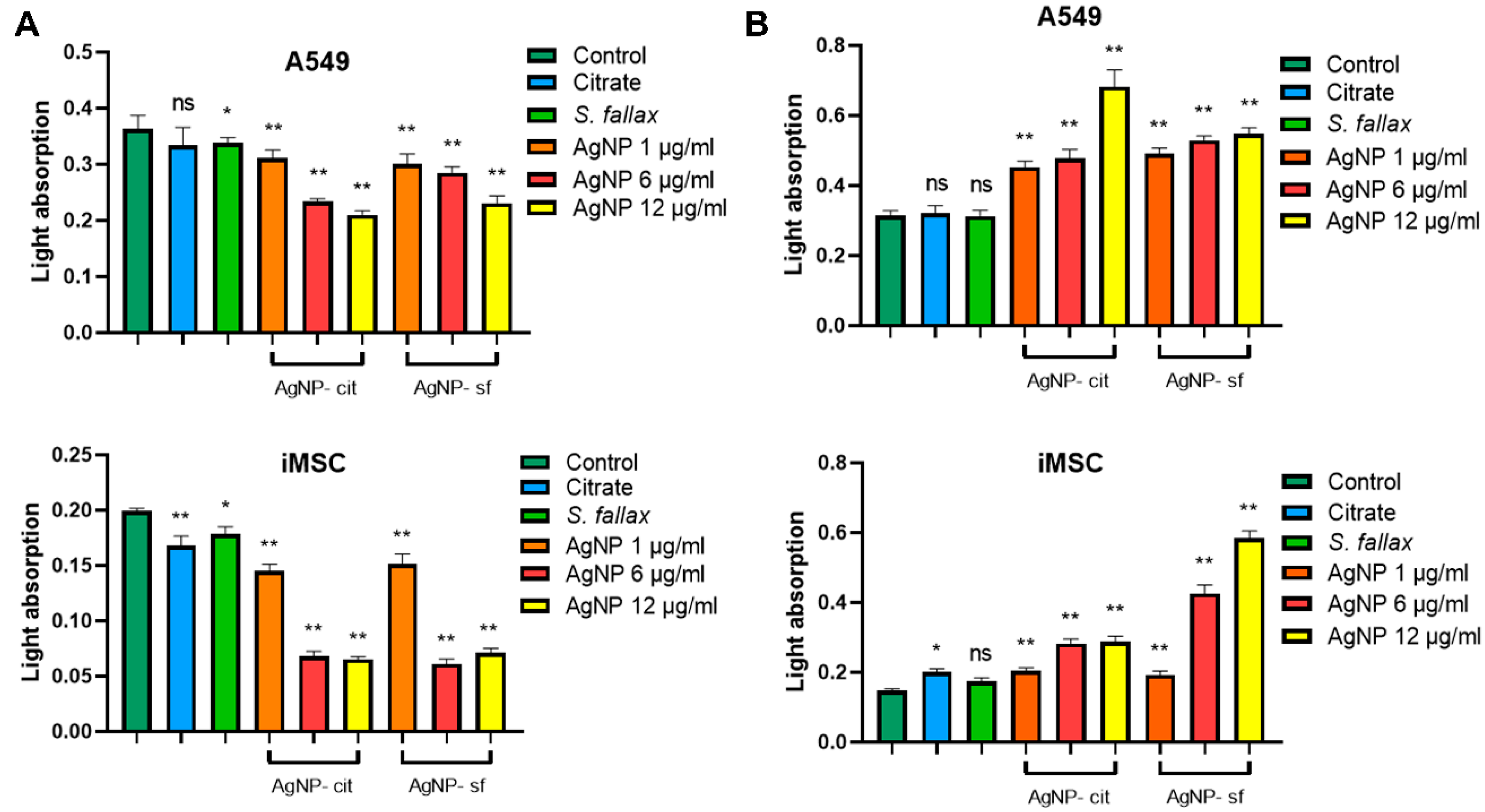
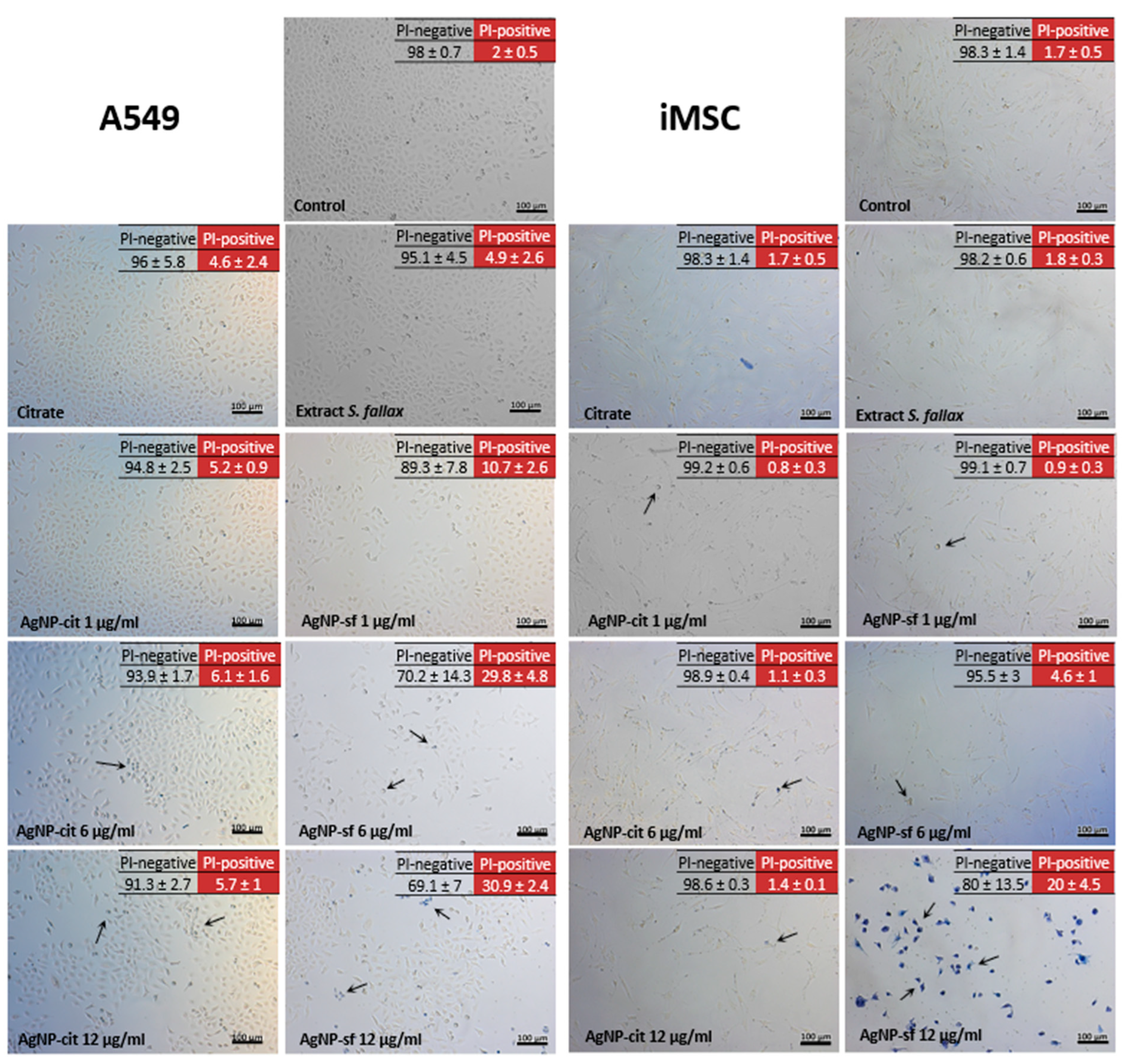
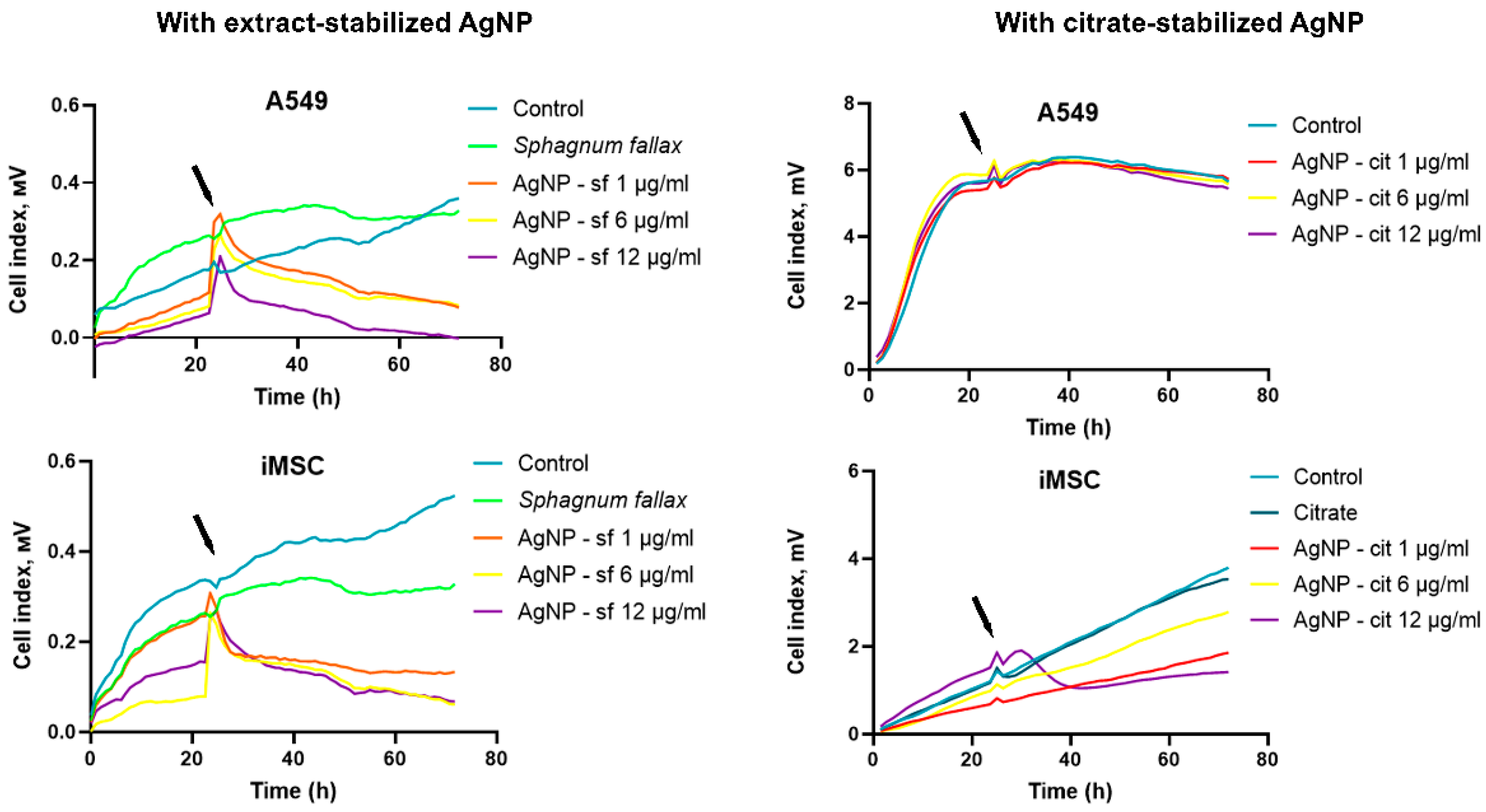
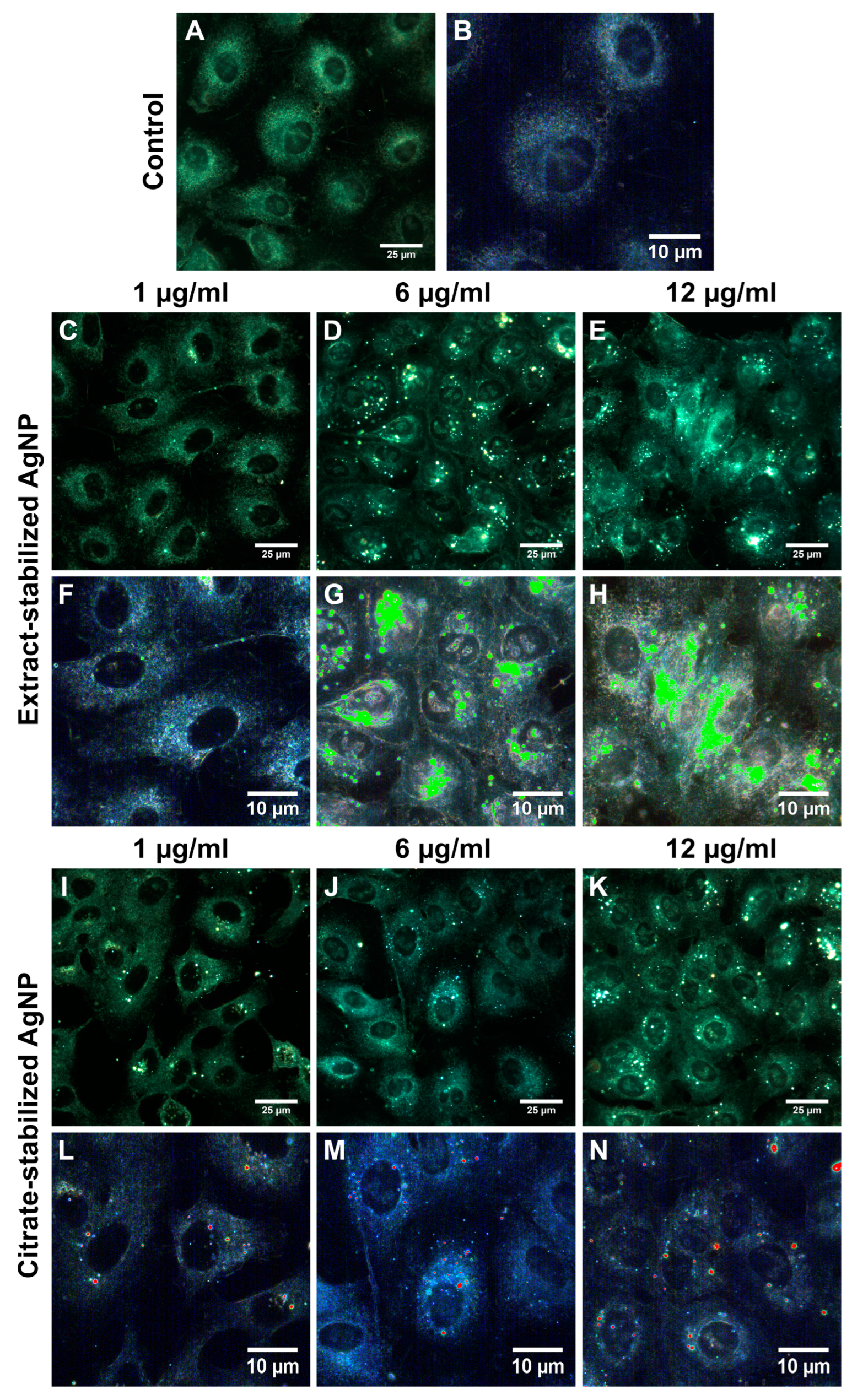
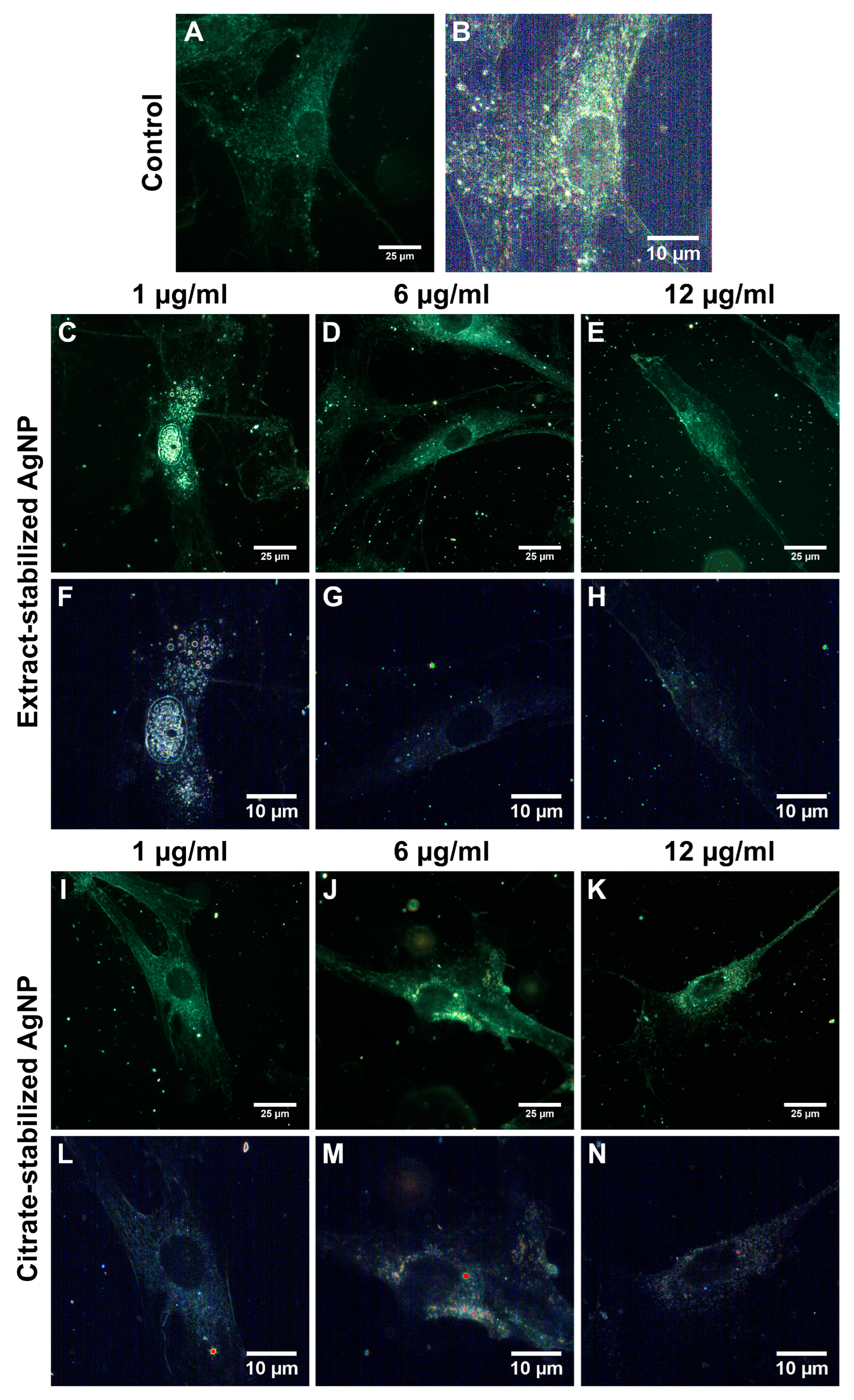
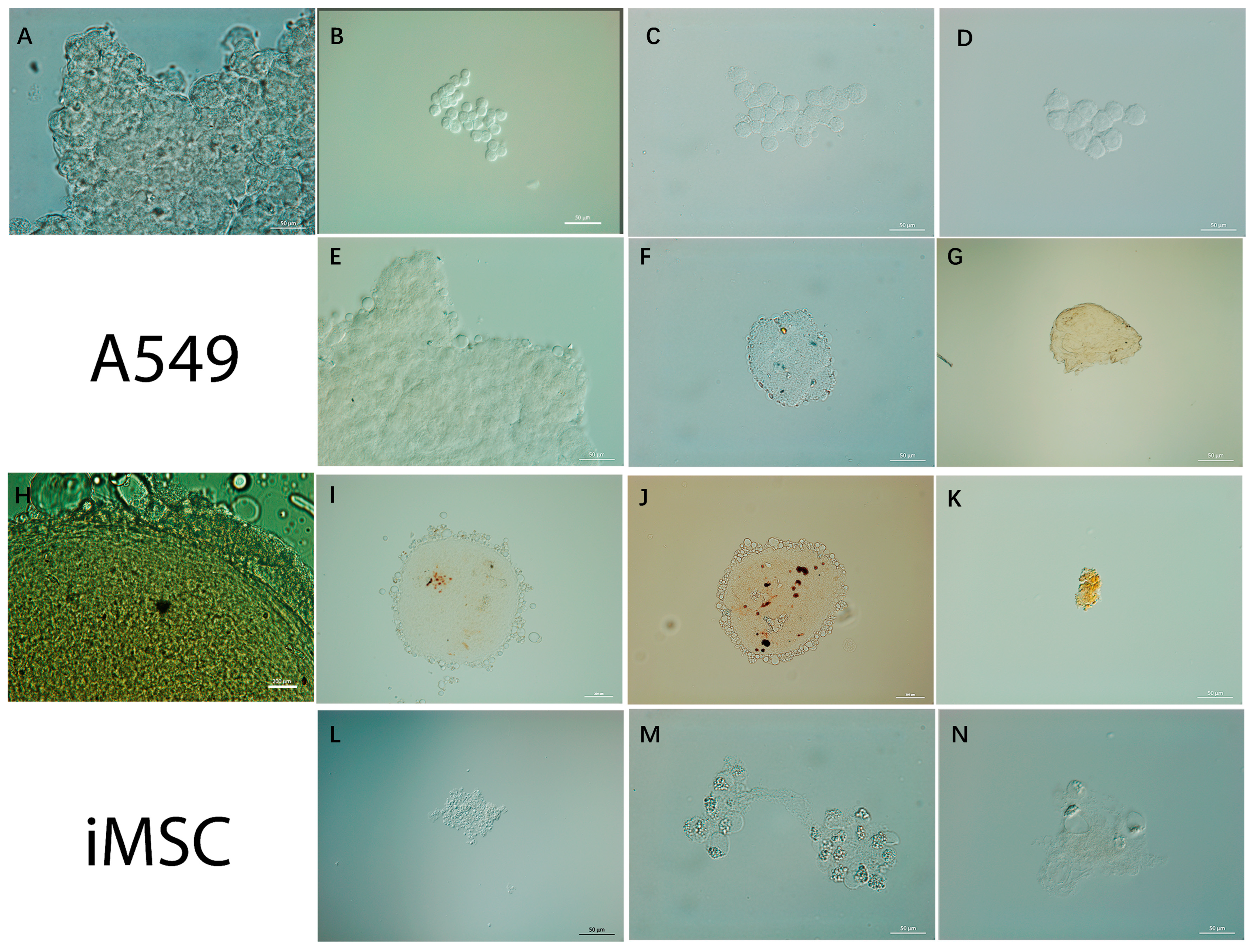
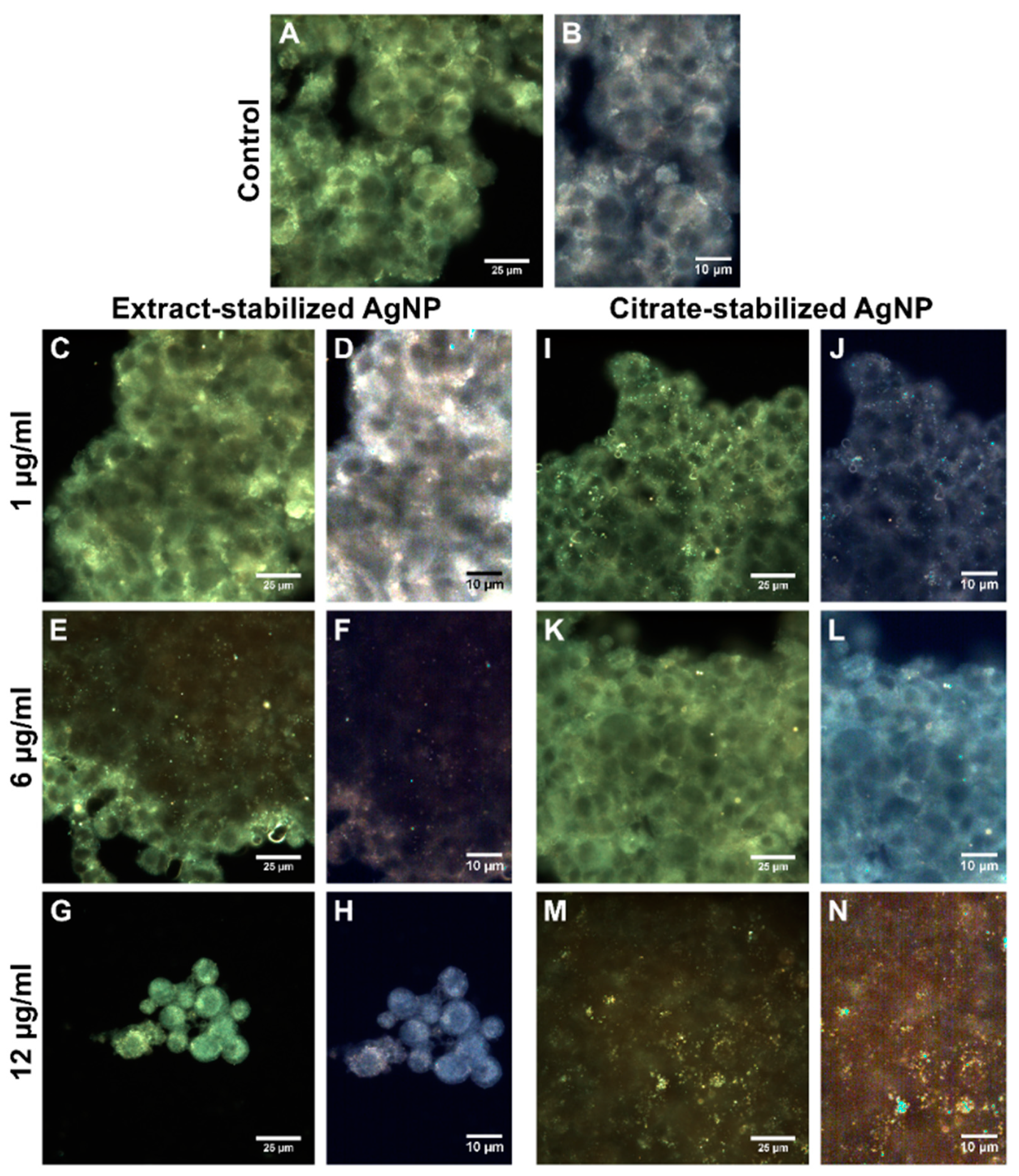
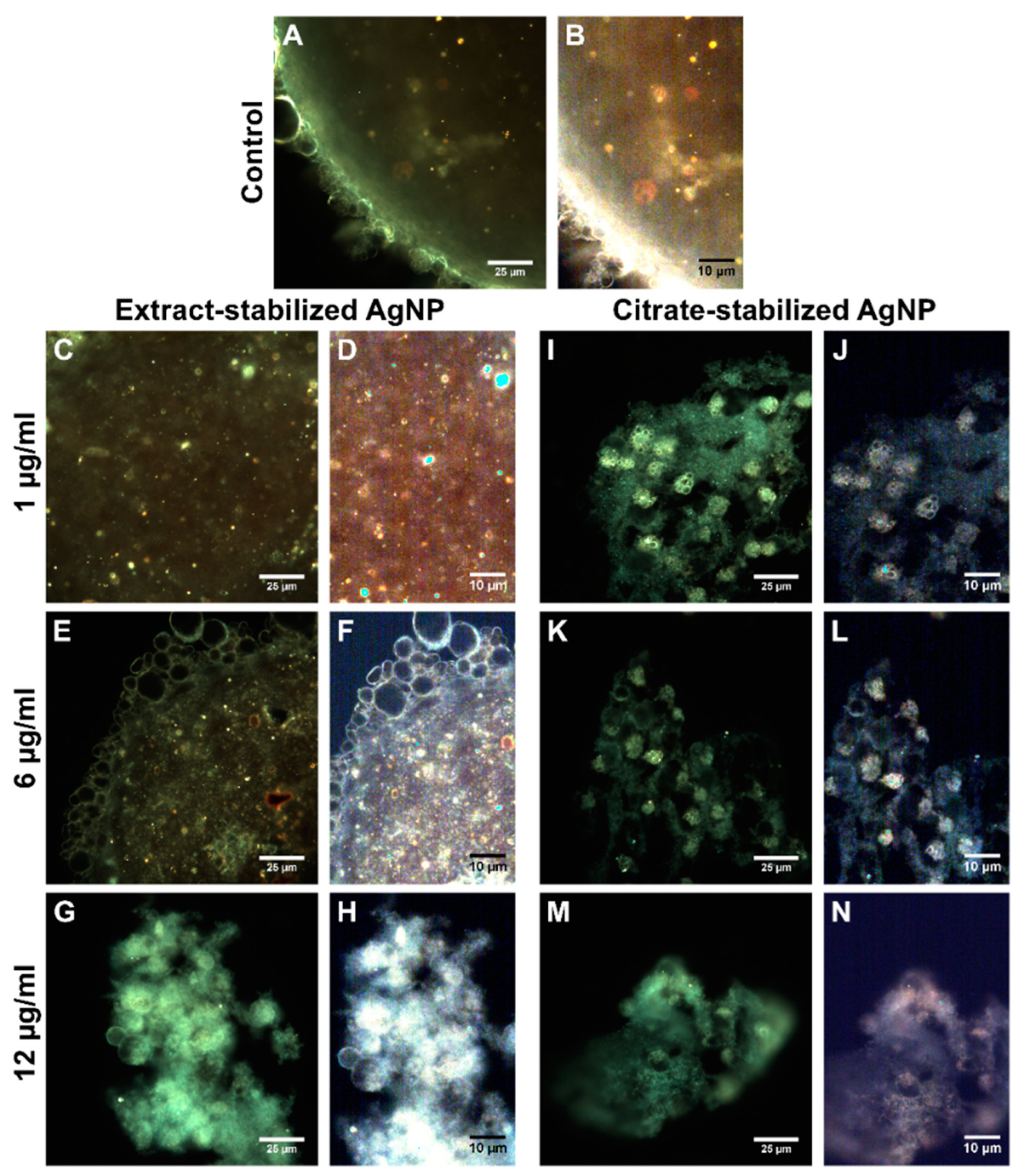
| Cellular Confluence, % | Control | Citrate | S. fallax | Citrate-Stabilized AgNPs | Extract-Stabilized AgNPs | |||||
| 1 µg/mL | 6 µg/mL | 12 µg/mL | 1 µg/mL | 6 µg/mL | 12 µg/mL | |||||
| A549 | 100 | 66 ± 6.1 | 100 ± 4.4 | 76 ± 6 | 63 ± 5.9 | 58 ± 4.6 | 49 ± 7.3 | 38 ± 4.5 | 25 ± 5.5 | |
| iMSC | 100 | 98 ± 5.3 | 77 ± 5.7 | 90 ± 5.3 | 63 ± 3.2 | 47 ± 3.5 | 68 ± 4.2 | 39 ± 3.1 | 16 ± 0.9 | |
Disclaimer/Publisher’s Note: The statements, opinions and data contained in all publications are solely those of the individual author(s) and contributor(s) and not of MDPI and/or the editor(s). MDPI and/or the editor(s) disclaim responsibility for any injury to people or property resulting from any ideas, methods, instructions or products referred to in the content. |
© 2024 by the authors. Licensee MDPI, Basel, Switzerland. This article is an open access article distributed under the terms and conditions of the Creative Commons Attribution (CC BY) license (https://creativecommons.org/licenses/by/4.0/).
Share and Cite
Iskuzhina, L.; Batasheva, S.; Kryuchkova, M.; Rozhin, A.; Zolotykh, M.; Mingaleeva, R.; Akhatova, F.; Stavitskaya, A.; Cherednichenko, K.; Rozhina, E. Advances in the Toxicity Assessment of Silver Nanoparticles Derived from a Sphagnum fallax Extract for Monolayers and Spheroids. Biomolecules 2024, 14, 611. https://doi.org/10.3390/biom14060611
Iskuzhina L, Batasheva S, Kryuchkova M, Rozhin A, Zolotykh M, Mingaleeva R, Akhatova F, Stavitskaya A, Cherednichenko K, Rozhina E. Advances in the Toxicity Assessment of Silver Nanoparticles Derived from a Sphagnum fallax Extract for Monolayers and Spheroids. Biomolecules. 2024; 14(6):611. https://doi.org/10.3390/biom14060611
Chicago/Turabian StyleIskuzhina, Liliya, Svetlana Batasheva, Marina Kryuchkova, Artem Rozhin, Mariya Zolotykh, Rimma Mingaleeva, Farida Akhatova, Anna Stavitskaya, Kirill Cherednichenko, and Elvira Rozhina. 2024. "Advances in the Toxicity Assessment of Silver Nanoparticles Derived from a Sphagnum fallax Extract for Monolayers and Spheroids" Biomolecules 14, no. 6: 611. https://doi.org/10.3390/biom14060611
APA StyleIskuzhina, L., Batasheva, S., Kryuchkova, M., Rozhin, A., Zolotykh, M., Mingaleeva, R., Akhatova, F., Stavitskaya, A., Cherednichenko, K., & Rozhina, E. (2024). Advances in the Toxicity Assessment of Silver Nanoparticles Derived from a Sphagnum fallax Extract for Monolayers and Spheroids. Biomolecules, 14(6), 611. https://doi.org/10.3390/biom14060611










